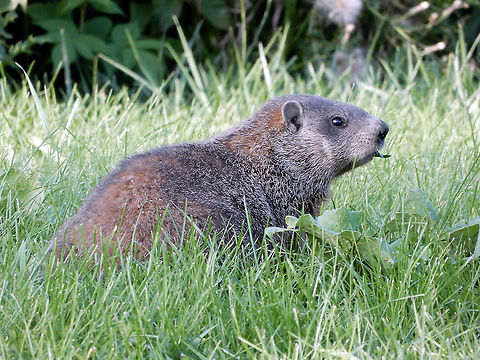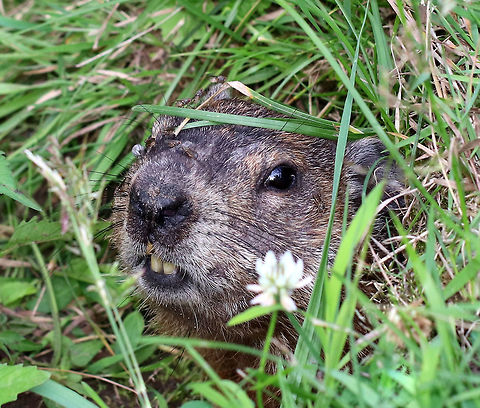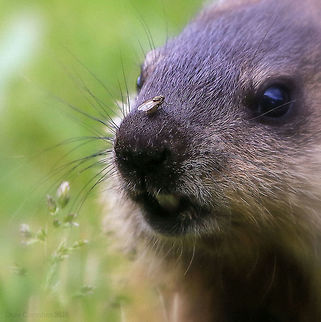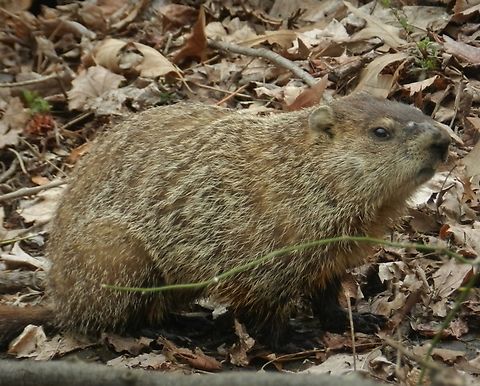
Appearance
The groundhog is the largest sciurid in its geographical range, typically measuring 40 to 65 cm long tail and weighing 2 to 4 kg. In areas with fewer natural predators and large amounts of alfalfa, groundhogs can grow to 80 cm and 14 kg.Groundhogs are well adapted for digging, with short but powerful limbs and curved, thick claws. Unlike other sciurids, the groundhog's spine is curved, more like that of a mole, and the tail is comparably shorter as well—only about one-fourth of body length. Suited to their temperate habitat, groundhogs are covered with two coats of fur: a dense grey undercoat and a longer coat of banded guard hairs that gives the groundhog its distinctive "frosted" appearance.

Naming
The etymology of the name "woodchuck" is unrelated to wood or chucking. It stems from an Algonquian name for the animal, "wuchak".
Distribution
It is widely distributed in North America and common in the northeastern and central United States as well as Canada. Groundhogs are found as far north as Alaska, with their habitat extending southeast to Georgia.
Behavior
Groundhogs are one of the few species that enter into true hibernation, and often build a separate "winter burrow" for this purpose. This burrow is usually in a wooded or brushy area and is dug below the frost line and remains at a stable temperature well above freezing during the winter months.In most areas, groundhogs hibernate from October to March or April, but in more temperate areas, they may hibernate as little as three months. To survive the winter, they are at their maximum weight shortly before entering hibernation. They emerge from hibernation with some remaining body fat to live on until the warmer spring weather produces abundant plant materials for food. Groundhogs are mostly diurnal, and are often active early in the morning or late afternoon.
Despite their heavy-bodied appearance, groundhogs are accomplished swimmers and excellent tree climbers when escaping predators or when they want to survey their surroundings. They prefer to retreat to their burrows when threatened; if the burrow is invaded, the groundhog tenaciously defends itself with its two large incisors and front claws. Groundhogs are generally agonistic and territorial among their own species, and may skirmish to establish dominance.
Outside their burrow, individuals are alert when not actively feeding. It is common to see one or more nearly-motionless individuals standing erect on their hind feet watching for danger. When alarmed, they use a high-pitched whistle to warn the rest of the colony, hence the name "whistle-pig".
Groundhogs may squeal when fighting, seriously injured, or caught by a predator. Other sounds groundhogs may make are low barks and a sound produced by grinding their teeth. When groundhogs are frightened, the hairs of the tail stand straight up, giving the tail the appearance of a hair brush.

Reproduction
Usually groundhogs breed in their second year, but a small proportion may breed in their first. The breeding season extends from early March to mid- or late April, after hibernation.A mated pair remains in the same den throughout the 31–32 day gestation period. As birth of the young approaches in April or May, the male leaves the den.
One litter is produced annually, usually containing two to six blind, hairless and helpless young. Young groundhogs are weaned and ready to seek their own dens at five to six weeks of age. Groundhog mothers introduce their young to the wild once their fur is grown in and they can see. They encourage their young to copy their behaviors and during this time may differ from usual routines.

Food
Mostly herbivorous, groundhogs primarily eat wild grasses and other vegetation, including berries and agricultural crops, when available. Groundhogs also eat grubs, grasshoppers, insects, snails and other small animals, but are not as omnivorous as many other Sciuridae.Like squirrels, they also have been observed sitting up eating nuts such as shagbark hickory, but unlike squirrels, do not bury them for future use. Groundhogs hydrate through eating leafy plants rather than drinking from a water source.

Predators
Common predators for groundhogs include wolves, cougars, coyotes, foxes, bobcats, bears, eagles, and dogs. Young groundhogs are often at risk for predation by snakes, which easily enter the burrow.References:
Some text fragments are auto parsed from Wikipedia.